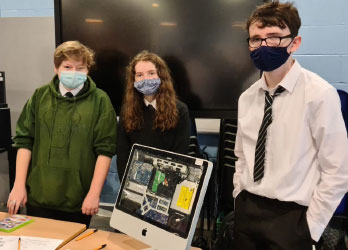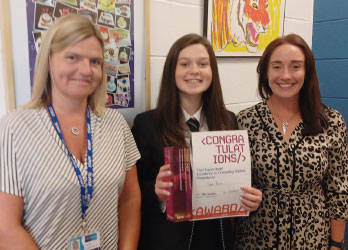
The background
Duncanrig Secondary School is a vibrant secondary school within the new town of East Kilbride in the South Lanarkshire Council area of Scotland. Catering for 1,700 young people aged 11 to 18, the school is a ‘true comprehensive’ with students from a range of backgrounds.
Everyone at the school is committed to working together to build positive futures for all, where learners develop respect for themselves, for those around them and for the school environment. The School Values – Ambition, Respect and Community – are established, allowing pupils to build their confidence, achieve their potential, contribute successfully to society and play an active part in shaping the future for themselves and others. It is therefore no surprise to find that this school has recognised for some time the importance of technology, and, uniquely, has put its young people at the centre of this strategy.
The school benefits from being part of South Lanarkshire Council’s long-standing relationship with RM, who provide a complete managed ICT service for all schools within the Council’s remit – a contract that dates back (in its current format) to 2013 and was recently extended to September 2025. This relationship ensures that the software and hardware in Duncanrig Secondary School are modern and reliable, providing the springboard for the school to go one step further with their Computing Pupil Ambassadors Scheme.
The Computing Pupil Ambassadors Scheme
The Senior Leadership Team at Duncanrig realised there was a “win-win-win” opportunity: to empower their young people, help hone the skills they would need in the outside world and address their own need for enhanced technology support. With that in mind, they developed the Computing Pupil Ambassadors Scheme – a group of volunteer pupils troubleshooting the technology needs of their peers, teachers and the administration staff running the school.
“Our young people are at the heart of everything in the school. We now have volunteers in every year group and every department. They meet regularly and have autonomy and ownership of this part of their learning. It gives them a sense of pride”.
Annette Alexander, Acting Head Teacher
The idea was launched, and very soon there was a (digital) queue of young people across the school wanting to get involved.
“I wanted to become a Computing Ambassador because I love the subject. It is like a puzzle. It is great to be in touch with others that love computing, and especially those more experienced than me as I know they would help me if I ever have any problems or struggles”.
Harry, S3 Ambassador Pupil

“For me, I became an ambassador to help improve other pupils’ experience in and about computing. I wanted to help them see how exciting computing can be. It was also a good opportunity to develop my teamworking problems solving skills”.
Jonny, S4 Ambassador Pupil
Under the guidance of the school leadership, the pupils set about agreeing a process whereby people could raise issues, before deciding how they would tackle them. They put up posters across the school with a QR code that could be scanned, leading to an online form that would capture the issue. This was then sent electronically to the team of Pupil Ambassadors to assess, and in many cases resolve, whilst in others they would “raise a ticket” with the service provider – in turn helping them too, by ensuring only the more complicated “tickets” were passed on.
Importantly, whilst the school leadership are there to offer support, they do not smother the younger people, recognising that to gain trust and get support, they must give them the freedom to develop the programme in the way they wanted it to evolve.
“As one of the seniors I help to make sure everything runs smoothly and everyone has a job to do. When I applied to be a Computing Ambassador at the end of S2, I was unsure whether they would accept my application, but I was welcomed with open arms”.
Emily, S3 Ambassador Pupil

As well as troubleshooting, the team of Pupil Ambassadors also support the staff in setting up equipment for lessons, assemblies, internal focus groups and even parents’ events.
“By empowering young people in this role it allows me to take a more strategic approach to ICT in the school whilst I am reassured that the school is operating seamlessly”.
Lesley Marshall, ICT Co-ordinator

The question to be asked, however, is “why” – what is in it for the pupils, and just as importantly, how does the school ensure that it does not get in the way of their schoolwork? Not surprisingly, there is a quick answer:
“Developing our young people is at the centre of this – setting them up for future life with the skills they need. That said, their volunteering is during lunchtimes and after school, and as an example, our S5 year group have had to step away recently to focus on their exams, but we were inundated with others wishing to step up into their place”.
Annette Alexander, Acting Head Teacher
For many, the Ambassador scheme is an ideal way to apply what they are being taught in the classrooms, it gives them a chance to turn a textbook lecture into a practical experience, whilst also enhancing confidence and softer skills into their education.
“The role as a Computing Ambassador is very rewarding and has given me great experience in leadership, advertising, planning and organising. It is more of a team where we all support and help each other to get the job done. We all share a love for computing science and its counter subjects and want to share that with other year groups. I hope to pass my role on to others in younger years as we begin to leave the school”.
Sarah, S5 Ambassador Pupil
Perhaps most excitingly is where next? Technology is evolving all the time, so how do they keep ahead? What comes after QR codes? What role does artificial intelligence play? Of what have they not even thought of that could be important tomorrow? Right now, there is minimal crossover with the service that RM provides to the school, but immediately the school can see opportunities – from visits to RM’s offices, to being opened up to CPD training that RM provide.
“As a Computing Ambassador, I aim to show how interesting computing is, especially for our younger students and those choosing their subjects. In an era of technology changing rapidly, I believe it is vital to motivate others to learn the basics of computing and promote this sufficiently”.
Eilidh, S5 Ambassador Pupil
The technology vision
So where did this all start? Duncanrig is a school that has recognised the importance of technology within their digital strategy, with Google Classroom adopted right across the school. This ensures that any young person who cannot be in school – for whatever reason – can continue their lessons. It means that as a Glow user, a tile on the Glow Launch Pad enables staff to book ICT rooms and request support via online forms; and it means that they use the same system to signal upcoming events that are happening across the school that week – digitally – with no need to print off posters or calendars.
“Wherever possible we avoid using paper. We do not have filing cabinets in the corner of offices – everything has gone digital”.
Lesley Marshall, ICT Co-ordinator

As a result, when the pandemic forced schools to close their gates to most pupils in 2020 and 2021, Duncanrig were better equipped than most, in that they already had a solid technology infrastructure in place, and – most importantly – had staff and pupils who were accustomed to using it. So, whilst it would be belittling the hard work that the school did to say that they moved seamlessly to remote learning, it is true that their ability to respond was fast and effective.
“What the pandemic did instil was a greater sense of consistency – we all had to do things in a similar way, using the same software – everything just had to be in Google Classroom”.
Annette Alexander, Acting Head Teacher
The school were recently awarded a Digital Schools Award – the national awards scheme set up to promote, recognise and encourage the use of digital technology within schools. Digital Schools Award Scotland recognises those secondary schools for the inclusion of computational thinking in the planning and delivery of digital technology in the school. The application from Duncanrig was one of the easier ones to write – and no doubt judge – as it almost wrote itself, based on the wealth of evidence provided by their Computing Pupil Ambassadors programme.
This is a school that knows where they are, and where they want to get to. A future vision that provides a computer device to every young person, is a natural next step, but right now is precluded on cost grounds.
“And remember – it is not just any 1-2-1 device – we have to have the right devices – hardware that starts up quickly, is reliable and runs the latest software. For example, as a Google school, iPads are not that helpful. And whilst we need more Chromebooks, desktops and laptops have their place too”.
Lesley Marshall, ICT Co-ordinator
Like most establishments, Duncanrig Secondary School recognises the importance of connectivity to glue their technology strategy together but the Local Authority made the decision early to invest in high quality broadband and wifi – something that has paid off such that connectivity is not a topic that the SLT at Duncanrig worry that much about – despite it being a constraint holding others back from following in similar footsteps.
Sharing best practice
- Trust the young people – at the start, Duncanrig did not know how this programme was going to evolve, but the SLT decided to embrace whatever happened, and by stepping back, allowed it to flourish into what it is today.
- ...with guidance from the top – whilst it is important to empower those doing the work, having someone within the organisation as a visible champion, addresses many obstacles. Someone who recognises the value and champions the cause. In the case of Duncanrig, this came from the Head, but was quickly adopted by other members of the senior team, too.
- Have a vision – this initiative was a key part of an overall commitment to making the school technology-led. It was also central to the values of the school, in seeking to empower young people and give them a say. Bringing the two together provided the framework for what followed.
- Education goes beyond the curriculum – whilst those who leave from Duncanrig do so with good grades, the school recognises that they have an obligation to equip them with the life skills too. Technology is likely to be a key part of whatever people do after school, so ensuring pupils get a chance to develop those skills is an important part of the education process.
The future
Building on that theme, technology is with us all. A school that embraces technology is usually a well-run establishment – lessons are enriched through engaging digital content, young people are encouraged to collaborate virtually and effectively, and communication is enhanced. Adopting technology at the core of all that you do can also help with your sustainability agenda – a cloud-based network means no more hot server rooms that need cooling, digital forms remove the need for wasteful printing, and online assignments replace hours spent at the photocopier.
But what stands Duncanrig Secondary School apart from other schools is not just their foresight in recognising all of this, and it is not even their “whole school” approach to things like the Computing Pupil Ambassadors Scheme (although that is part if it). What is distinctive about this school is the enthusiasm and the commitment of its leadership. They recognise the role that technology can play in helping them achieve their goals – and they then turn that vision into a reality. For them they do not know what the future holds, but they are certainly going to have fun finding out.
“My experience as a Computing Ambassador at Duncanrig Secondary School is an experience that I will carry with me for the rest of my life”.
Sarah, S5 Ambassador Pupil
Download a PDF of the case study